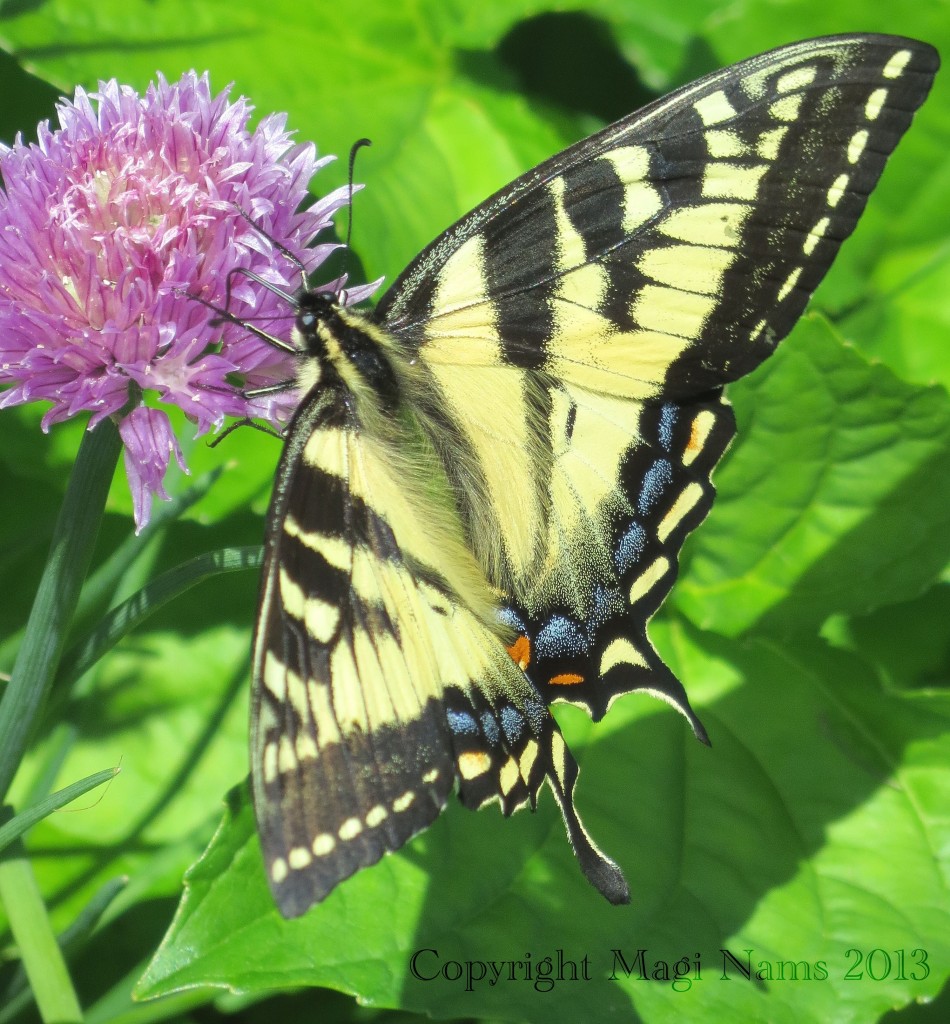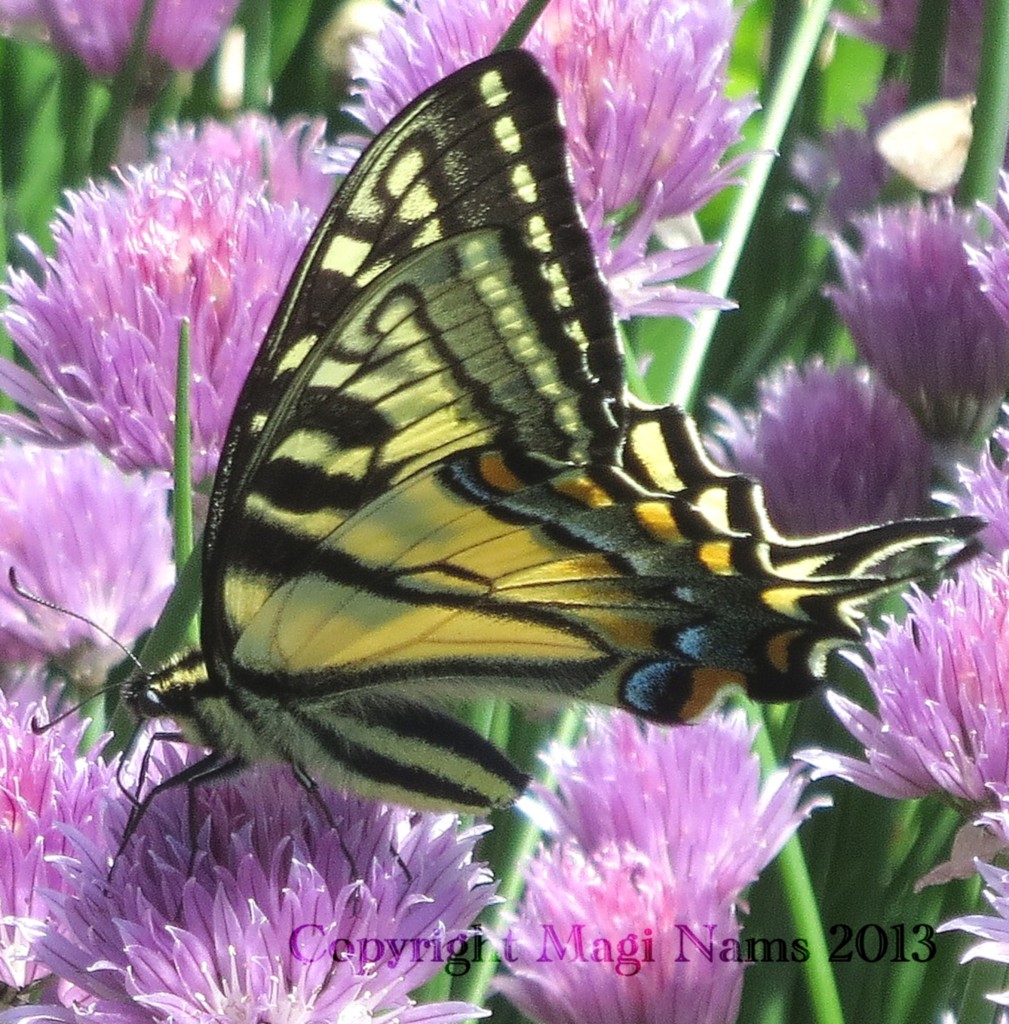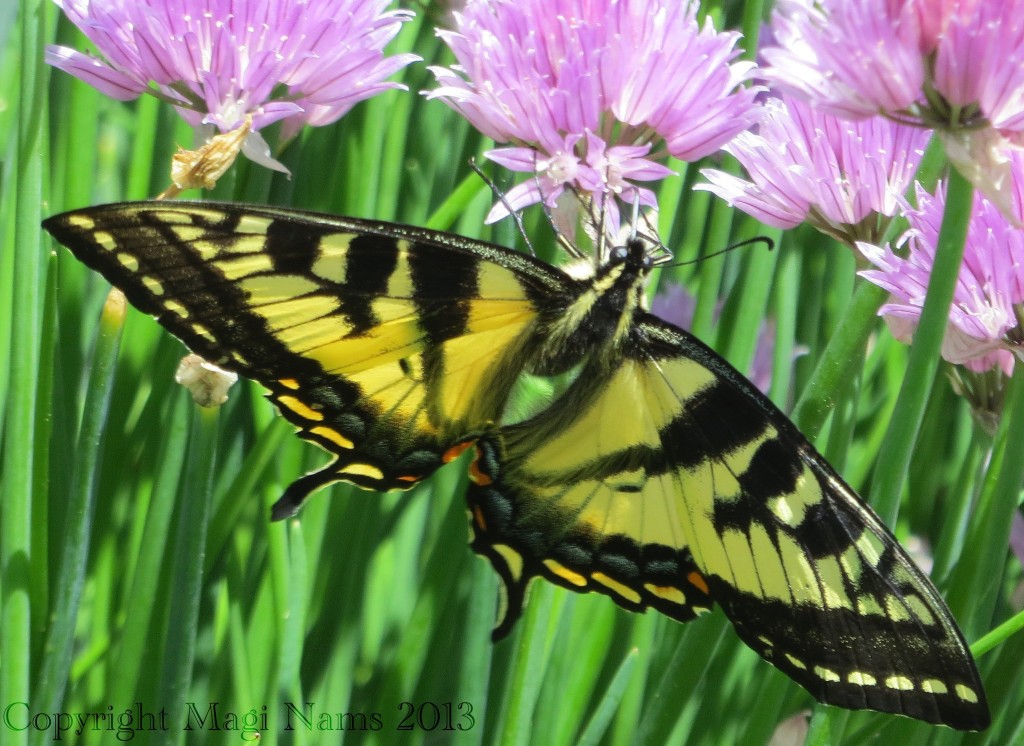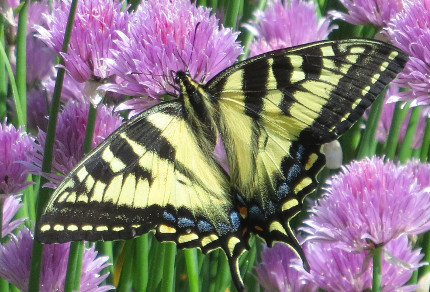
Canadian Tiger Swallowtail
Summer’s here! Officially, it arrived around 2 a.m., and today is that glorious peak on the sine curve of change of hours of daylight. We’re standing on the Everest of sunshine in the Northern Hemisphere, December’s deep canyon and its short winter days nearly out of sight far below at the bottom of sine curve, which I always equate with a ribbon’s curving path when you flick it smoothly up and down.
During the past month, I abandoned blogging for gardening, tackling the rush of spring chores necessary to have my yard and gardens ready for summer – weeding, tilling, feeding with compost, planting, transplanting, pruning, guarding from pests. And on this first day of summer, the harvests are already pouring in. We’ve enjoyed fresh salads incorporating arugula, lettuce, spinach, Swiss chard, kale, radishes, dill, and chives for nearly a month, and asparagus, as well as rhubarb desserts, for several weeks. Two days ago, I picked our first honeyberries, and this morning I found one red strawberry, ripe and delicious, in our early strawberry bed. Brown rot has stolen nearly all our sweet cherries, and white-tailed deer continue to scout the Nams Garden and Flowerbed Delicatessan for luscious treats; however, yesterday, I experimented with a milk/warm water/soap spray to mitigate brown rot damage on my remaining stone fruits, and the Plantskydd blood-based deer deterrent I’ve been spraying on my roses, lilies, and young fruit trees seems to be doing its job.

Canadian Tiger Swallowtail on Chive Flower
Two of my greatest joys associated with gardening are listening to songbirds and watching butterflies while I tend vegetables, fruits, and flowers. Yesterday, a male ruby-throated hummingbird performed parabolic courtship flights right beside me. American robins and a northern flicker gleaned insects or worms from the lawn. An eastern phoebe swooped from its hunting perch on a young ornamental cedar to catch insects on the fly, and a rusty-capped male chipping sparrow sang his metallic trill from a spruce windbreak. American goldfinches, song sparrows, cedar waxwings, and a kinglet flitted about in birches, apple trees, or spruces edging our yard. I watched a skipper feed on vetch nectar in a meadow beyond my compost heap, and caught glimpses of Canadian tiger swallowtails flying erratically among the fruit trees. Several times during the past two weeks, I’ve rushed to get my camera to photograph a swallowtail, only to have it wing away before I could snap its portrait. However, yesterday, intoxicated with chive nectar, one allowed me to capture its beauty.

Canadian Tiger Swallowtail on Chives
Canadian tiger swallowtails, Papilio canadensis, belong to the butterfly family Papilionidae and are cousins to the exquisite Cairns birdwings and Ulysses swallowtails Vilis and I saw in Queensland, Australia. All swallowtails are large butterflies which usually have black in their colour patterns, often complemented by yellow, green, white or blue. Both male and female Canadian tiger swallowtails are yellow and black with blue and orange scales on their hindwings. The ‘tiger’ refers to the very noticeable black stripes on the swallowtail’s forewings. Melanistic (dark) females occur, but are extremely rare. (1)

Female Canadian Tiger Swallowtail
This tiger swallowtail species is common to abundant throughout most of Canada and even occurs north of the tree line. It inhabits open woodlands and woodland edges, where the adults feed on flower nectar. Females lay round eggs singly on the leaves of a variety of trees including ashes, cherries, willows, and poplars (all occur in my yard), which provide food for larvae after the eggs hatch. Young larvae are brown and white, camouflaged as bird turds. Mature larvae are bright green with large eyepots, also a defensive colouration, since the larvae supposedly resemble snakes. Canadian tiger swallowtails produce a single generation per year and fly from May through July. (1)

Canadian Tiger Swallowtail
I’ve planted numerous butterfly-friendly plants in my flowerbeds, notably Budleia (butterfly bush), Monarda (bee balm), and Echinacea (coneflower). However, in my experience, common garden chives are a butterfly lover’s best attractant for tiger swallowtails. Mine are in full blosssom and seem to be irresistable to these flashy lepidopterans. So, if you want Canadian tiger swallowtails to visit your yard, plant several clumps of easy-to-grow chives in full sun and look for these beauties to arrive come summer. If you have suggestions for different plants which attract Canadian tiger butterflies or other eastern Canadian butterflies, I’d love to hear from you. Happy gardening!

Canadian Tiger Swallowtail and Chives
1. Butterflies of Canada. http://www.cbif.gc.ca/spp_pages/butterflies/species/CanadianTigerSwallowtail_e.php



Beautiful photos! My husband’s the gardener. I’ll have to get him to read your post. He loves having the butterflies and hummingbirds around. It’s the deer he complains about. 🙂
Thanks, Paula! Your husband may want to try the Plantskydd deer repellent. It’s available at Canadian Tire. Every few weeks, I walk around my yard and spritz vulnerable plants with it. It stinks until it dries, but then you don’t smell it. So far, my roses and lilies are still intact!
Magi
Beautiful photographs, Magi. I love gardens but they’re a lot of work.
Hi Anne! Thanks for stopping by my blog. You’re right, gardens are a lot of work. I get up very early to work outdoors while it’s cool, then putter indoors before heading to my writing desk. For me, a summer of gardening and writing is perfect. 🙂
Magi